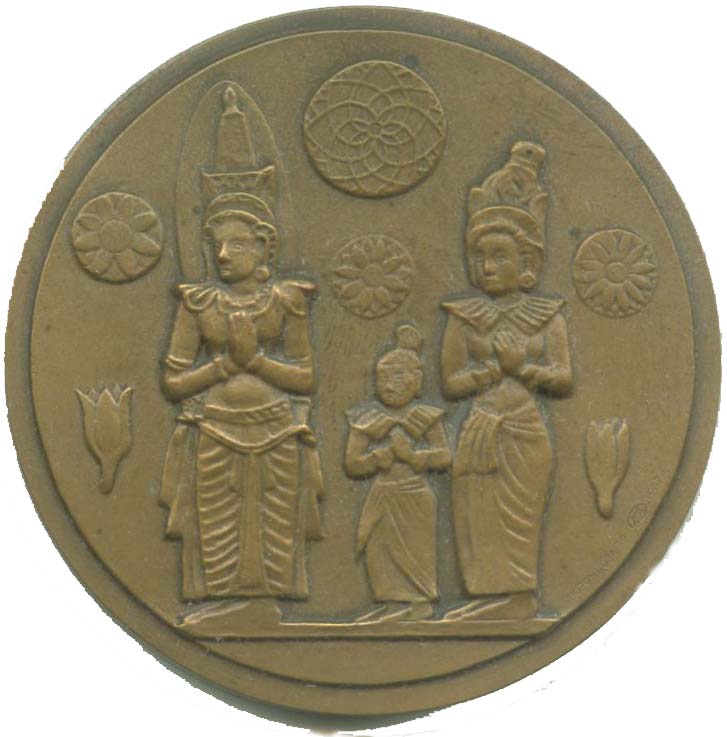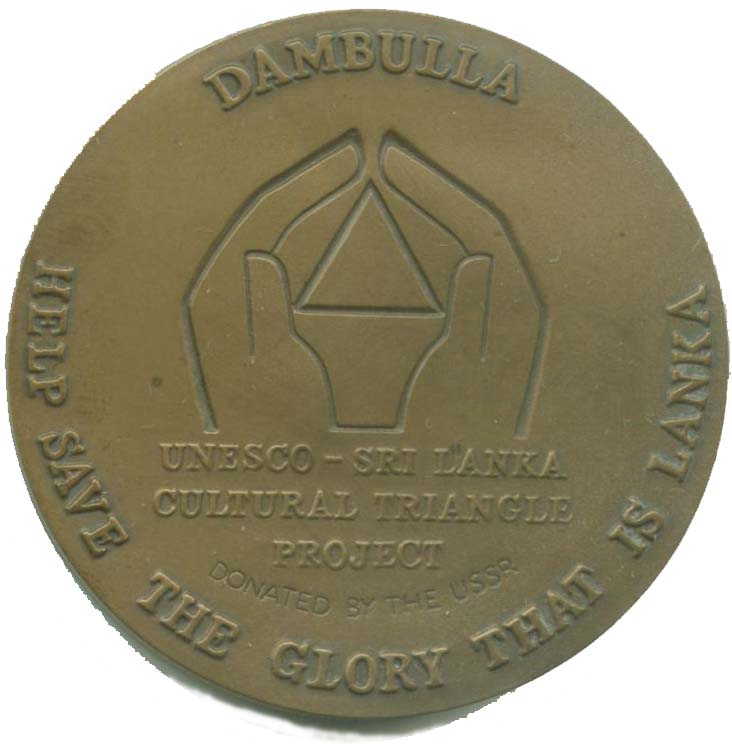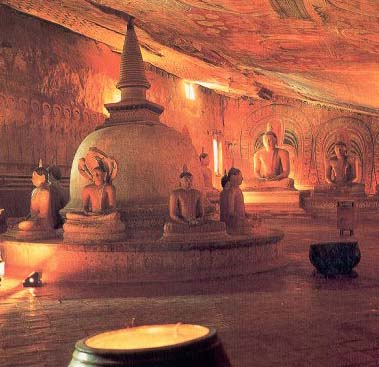| SPECIFICATIONS | |
| Alloy | Brass |
| Type | Struck |
| Diameter | 59.8 mm |
| Thickness | 6.9 mm |
| Weight | ~113 gms |
| Shape | Round |
| Edge | Plain |
| Die Axis | 0° |
| Mint | USSR |


|

| 
| ||||||||||||||||||||
International Council on Monuments and Sites in it's 1989 evaluation said I. Historical Background
 The rock of Dambulla is the center of a Buddhist cave-temple complex
established in the 3rd century BCE and occupied continuously to this
day. Its location has marked a transportation node between the Eastern
and Western Dry Zones and between the Dry Zones and the central
mountains throughout the history of Lanka. The cave-temple
complex is established on an inselberg or erosional remnant of
importance in the study of the island's geological history. The 25
hectare site proposed for inscription also includes evidence of human
occupation going back to the prehistoric period, including the recently
excavated megalithic cemetery at Ibbankatuwa.
The rock of Dambulla is the center of a Buddhist cave-temple complex
established in the 3rd century BCE and occupied continuously to this
day. Its location has marked a transportation node between the Eastern
and Western Dry Zones and between the Dry Zones and the central
mountains throughout the history of Lanka. The cave-temple
complex is established on an inselberg or erosional remnant of
importance in the study of the island's geological history. The 25
hectare site proposed for inscription also includes evidence of human
occupation going back to the prehistoric period, including the recently
excavated megalithic cemetery at Ibbankatuwa.
The site has been in continuous use for over 22 centuries, when it was occupied by a Buddhist monastic establishment, following the arrival of Buddhism on the island. Remains of 80 rock shelter residences established at that time on the site have been identified. Likely in the 1st century B.C., the uppermost group of shelters on Dambulla's South face were transformed into shrines. These transformations continued and were intensified between the 5th and 13th centuries: cave-temples were extended into the sheltering rock, and brickwalls constructed to screen the caves. By the end of the 12th century, with the introduction by King NissankaMalla of sculpture to the caves on the upper terrace, echoing the rock carving that had preceded it, the caves assumed their present general forms and layout.
 The next major phase of development took place in the 18th century
when following a long-standing tradition, the upper terrace was
restored and refurbished. All of the painted surfaces within the caves
were painted or over painted in a style characteristic of the Kandy
school of the late 18th century. At that time, the modest Buddhist
figures in the caves were repainted, maintaining original details and
iconography; the fronting screen walls were rebuilt and roofed to form
an outer veranda. Throughout the 19th century, following the loss of
royal patronage in 1815, periodic repainting of sculptures and
deteriorating surfaces continued. In 1915, thanks to the efforts of a local
donor, cave no5 was entirely repainted. And in the 1930's, the veranda
was rebuilt incorporating a mixture of European and Asian detailing,
and the complex's entrance porch was reconstructed in a conjectural
18th c. style.
The next major phase of development took place in the 18th century
when following a long-standing tradition, the upper terrace was
restored and refurbished. All of the painted surfaces within the caves
were painted or over painted in a style characteristic of the Kandy
school of the late 18th century. At that time, the modest Buddhist
figures in the caves were repainted, maintaining original details and
iconography; the fronting screen walls were rebuilt and roofed to form
an outer veranda. Throughout the 19th century, following the loss of
royal patronage in 1815, periodic repainting of sculptures and
deteriorating surfaces continued. In 1915, thanks to the efforts of a local
donor, cave no5 was entirely repainted. And in the 1930's, the veranda
was rebuilt incorporating a mixture of European and Asian detailing,
and the complex's entrance porch was reconstructed in a conjectural
18th c. style.
2. Significance and Authenticity
Dambulla is an extraordinary and unique complex. It is the second largest cave-temple complex in South and Southeastern Asia, after Ajanta in India, and its 18th c. rock paintings are among the best preserved in the entire region. The extent of the painted surfaces in the five caves exceeds 21,000 square feet; 157 statues of various sizes are also present.
A Lankan expression of a Southern Asia temple concept, Dambulla is without doubt the largest and best preserved in the country. Uniquely among comparable sites in India such as Ajanta, Elephanta, Ellore and Karla (which are natural caves), it is largely an excavated complex -no comparable examples exist. One of the spaces, cave #2, is undoubtedly one of the single most dramatic and artistically important spaces in all of Asia.
As well, the 25 hectare cultural landscape proposed for inscription bears witness in its richly layed composite nature to the use of the entire site for close to four millenia. The larger site incorporates a set of individual units reflecting all phases of site development from the megalithic period to the present day, including a monastic chapter house, bo-tree temple, dagoba, and the earliest known village revealed by archaeological research in Lanka. Those are located within a site of considerable natural beauty and power.
- Criterion I. The monastic ensemble of Dambulla is an outstanding example of the religious art and expression of Lanka and South and Southeast Asia. The excavated shrine-caves, their painted surfaces and statuary are unique in scale and degree of preservation. The monastery includes significant masterpieces of 18th c. art, in the Lankan school of Kandy.
- Criterion VI. Dambulla is an important shrine in the Buddhist religion in Lanka.
For 7 beautiful interactive spherical panoramic views of Dambulla look at images
The medal which is one of a set of six were minted in 1987 and donated by USSR, to Central Cultural Fund (CCF) probably as a fund raiser.
The Medal was scanned at 300 dpi and displayed at 100 dpi. It was purchased in 2005 March from CCF office in Kandy.